In the vibrant 1950s, men's shoes became a canvas for self-expression and cultural shifts. You'd often spot saddle shoes in black and white, perfect for casual outings. Loafers, particularly penny loafers, were a staple with their effortless style and comfort. Rockabilly boots added a rebellious flair with their pointed toes and shiny finishes. Formal occasions called for lace-up patent leather oxfords or two-tone dress shoes that made bold statements. Each shoe represented more than just footwear; they were symbols of individuality and youth culture. There's so much more to explore about these iconic styles and their lasting impact.
Overview of 1950s Shoe Styles
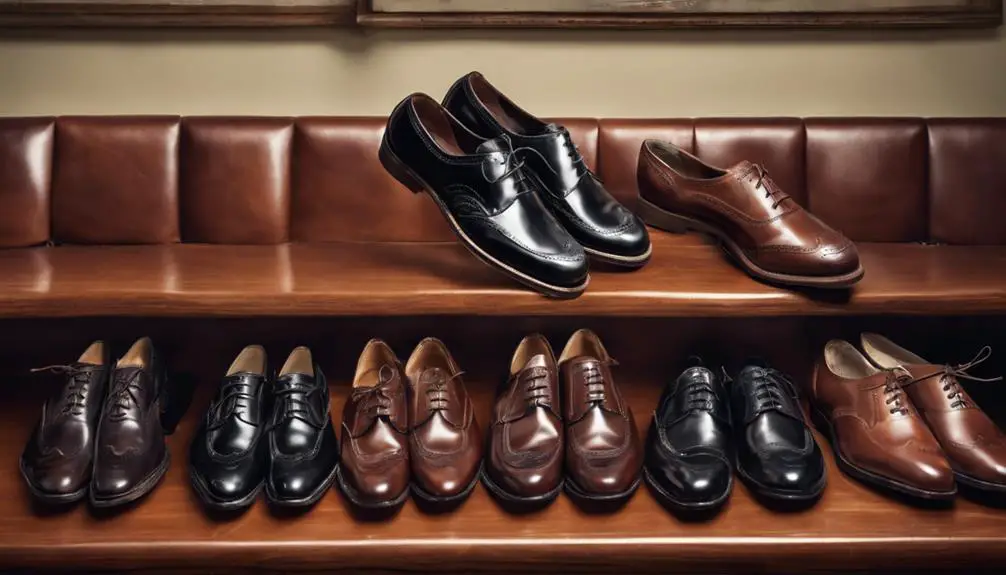
The 1950s ushered in a vibrant array of shoe styles that mirrored the cultural upheaval of the time. You could strut your stuff in saddle shoes, those classic black and white beauties that became synonymous with casual and semi-formal outfits. They offered a fresh, youthful vibe, often seen on the feet of the era's trendsetters.
Loafers also emerged as a staple, perfect for the guy who valued both style and comfort. With options like penny and tassel loafers, you had the versatility to dress up or down, making them a must-have in any wardrobe. Picture yourself slipping them on effortlessly, ready for a night out or a casual day at school.
Then there were the rockabilly boots, a true embodiment of rebellion. With their pointed toes and unique stitching, these boots were the choice of musicians and those wanting to make a statement. They encapsulated the spirit of the youth culture, defying traditional norms and boldly proclaiming individuality.
In this decade, footwear wasn't just about function; it was a powerful expression of identity and cultural shifts.
Popular Casual Footwear
Casual footwear in the 1950s was all about blending comfort with style, giving you the perfect options for any laid-back occasion. Among the standout choices were loafers, especially penny and tassel styles, which became versatile staples for both casual and semi-formal events. You could easily dress them up or down, making them a must-have in your wardrobe.
The saddle shoe also made waves, with its striking black-and-white color contrast. These shoes were the go-to for youth, often paired with rolled-up jeans or khakis, creating a classic look that spoke to the era's youthful spirit.
Chukka boots entered the scene, offering an ankle-high design that was both stylish and relaxed, perfect for a casual outing. The rise of rockabilly culture even influenced footwear trends, with pointed-toed dress boots becoming fashionable among musicians and the youth alike.
| Footwear Type | Description |
|---|---|
| Loafers | Comfortable, versatile slip-ons |
| Saddle Shoes | Classic black-and-white contrasting style |
| Chukka Boots | Stylish ankle-high elegance |
| Canvas Sneakers | Casual, comfortable choices like KEDS and Converse |
Iconic Formal Shoe Designs
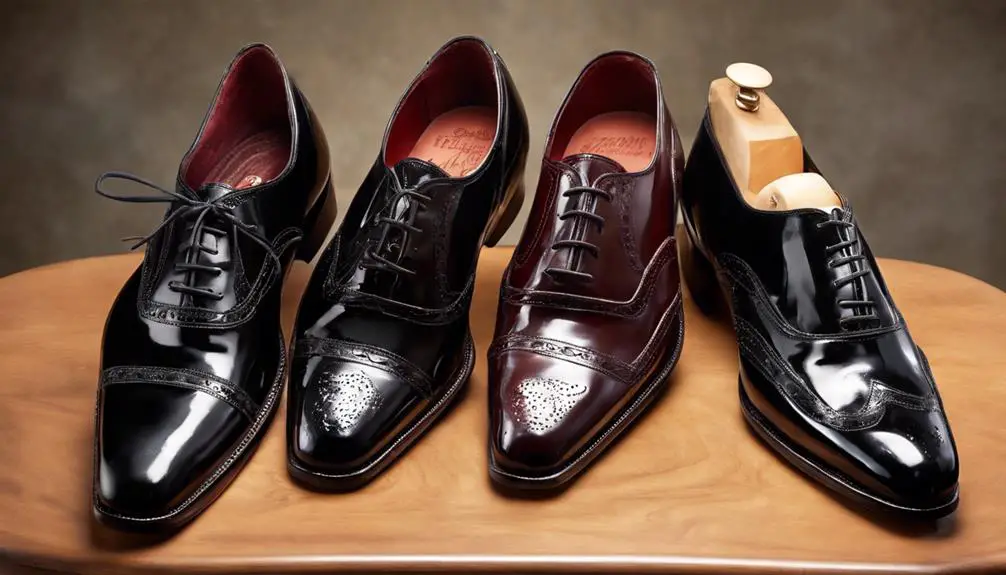
Formal shoe designs in the 1950s truly defined sophistication and style, capturing the essence of the decade's fashion. You couldn't go wrong with a pair of lace-up patent leather oxfords; they were the quintessential choice for formal occasions, effortlessly complementing any suit. The era also embraced the black and white oxford, a striking design that showcased a classic vintage style, perfect for making a statement at any event.
Another standout was the two-tone dress shoe, which combined contrasting colors to create a vibrant look that appealed to the youth of the time. These shoes exuded flair, and you'd definitely stand out in a crowd. For those seeking a bit of flair without sacrificing elegance, wingtip oxfords offered decorative perforations and brogue detailing, making them ideal for both business and formal settings.
Don't forget the saddle shoes, either! Though often seen in more casual contexts, their distinctive contrasting colors made them a favorite among young men, bridging casual and semi-formal attire seamlessly. Each of these iconic designs played a significant role in shaping men's formal footwear, leaving a lasting legacy in the world of fashion.
The Rise of Loafers
Emerging as a fashionable staple in the 1950s, loafers quickly caught on with those seeking a blend of comfort and style. These versatile slip-on shoes, often crafted from luxurious leather, became the go-to choice for both casual outings and formal events. Among the various styles, the penny loafer gained iconic status, featuring a distinctive slot designed to hold a penny, embodying a vintage charm that resonated with the era's youth.
Loafers perfectly complemented the preppy fashion trend, appealing to college students and young professionals who wanted to project a polished yet relaxed image. Their ease of wear and comfort made them a must-have in many men's shoes collections of the decade. You could slip them on effortlessly, whether you were heading to a lecture or a weekend gathering.
Saddle Shoes and Their Appeal
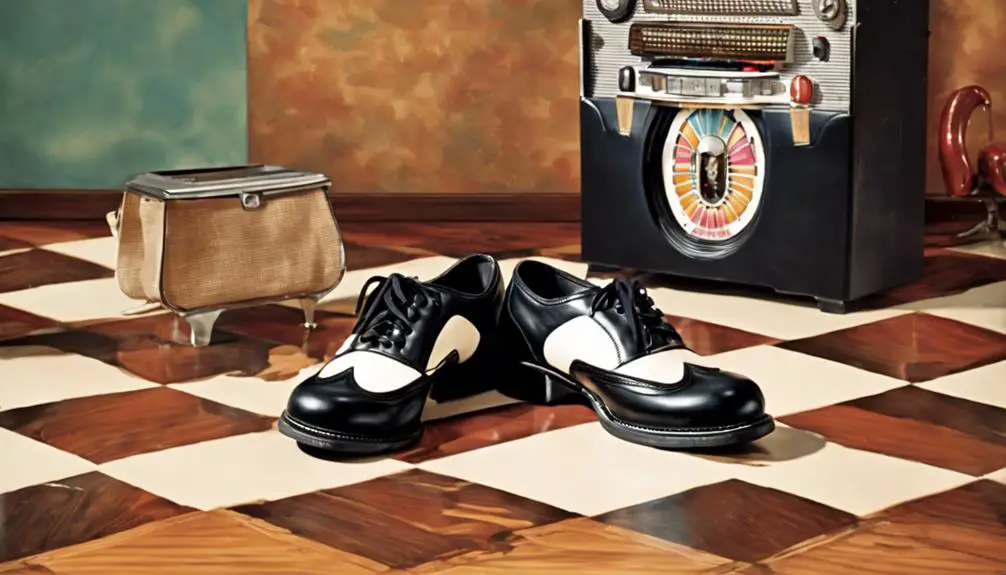
What makes saddle shoes such an enduring symbol of 1950s youth culture? Their distinctive black and white design sets them apart, creating a striking contrast that captures attention. You see, saddle shoes weren't just footwear; they represented a change in fashion. Worn by teenagers and college students alike, these shoes perfectly complemented the casual attire of the era, often paired with rolled-up jeans or khakis.
Their appeal lies in their versatility, effortlessly shifting from laid-back outings to semi-formal events. Imagine stepping into a dance hall in a crisp button-up, with those classic saddle shoes grounding your look—it's a perfect blend of cool and classy. Plus, their association with the rock 'n' roll movement only boosted their popularity, as youth rebelled against traditional fashion norms.
Saddle shoes became a staple, not just for their style but for what they symbolized: freedom, individuality, and a break from the past. Whether you were at a sock hop or just hanging out with friends, wearing saddle shoes made a statement about who you were and the era you embraced. Embracing these shoes means embracing the spirit of the 1950s.
Rockabilly Boots and Trends
Rockabilly boots captured the essence of youthful rebellion in the 1950s, becoming a must-have for anyone wanting to embrace the era's edgy style. These men's boots were characterized by their pointed toes and high shine finishes, often adorned with unique stitching and embellishments that reflected the bold spirit of the rockabilly subculture.
Popularized by musicians and trendsetters, rockabilly boots were frequently paired with denim jackets or leather jackets, creating an iconic look that merged rock, country, and rhythm and blues influences. Styles like engineer boots and western-inspired designs became staples, symbolizing defiance against the traditional norms of the time.
Choosing rockabilly boots meant more than just fashion; it was a statement of identity and a celebration of youth culture. You'd step into the spotlight, feeling the rebellious vibe with every stride. As you donned your leather boots, you joined a community that valued individuality and expression, leaving behind the conservative styles of the past. If you wanted to make a statement in the 1950s, slipping into a pair of rockabilly boots was the way to do it.
Influence of Music and Culture
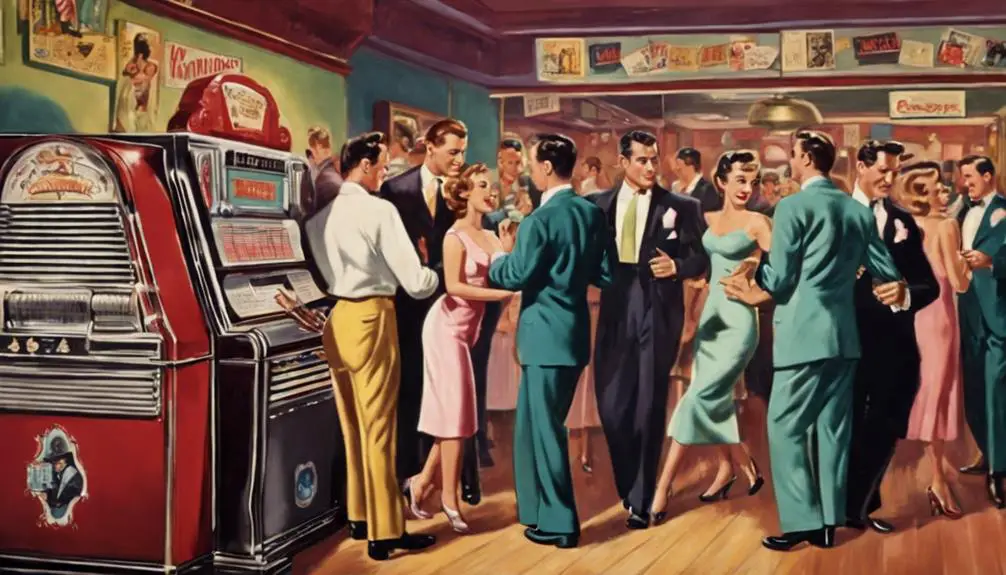
The vibrant music scene of the 1950s played a pivotal role in shaping men's footwear trends, turning shoes into powerful symbols of youth identity and rebellion. As rock 'n' roll surged, you saw unique styles emerge, especially rockabilly boots and saddle shoes, which defined the decade's fashion.
These shoes weren't just about utility; they were statements. Consider the following styles that encapsulated the era:
- Rockabilly Boots: With their pointed toes and high shine, these boots were a staple for musicians and fans alike, embodying a daring spirit.
- Saddle Shoes: Their iconic black and white pattern made them a favorite among teenagers, perfectly matching denim and casual wear.
- Dress Shoes Mens: While more formal, these shoes reflected an evolving sense of style, combining elegance with the youthful exuberance of the time.
- Greaser Style: Sported by rebels, this look showcased how footwear became a canvas for self-expression amid social changes.
In the 1950s, your shoes spoke volumes about who you were, capturing the essence of a generation that embraced music, culture, and individuality.
Key Brands and Models
As the vibrant music and cultural movements of the 1950s influenced personal style, key brands emerged, shaping the footwear landscape of the decade. You'd find yourself drawn to HuitJours, renowned for its stylish two-tone penny loafers and casual boat shoes that perfectly captured the era's lively spirit. If you aimed for a polished look, Stacy Adams offered navy oxfords and wingtip styles, embodying the formal aesthetic that many men desired.
For those who appreciated bold statements, Ferro Aldo gained popularity with its black and white spectator dress shoes, showcasing the unique color combinations favored in 1950s footwear. Meanwhile, Clarks produced vintage loafers that combined brown and white leather, appealing to the preppy youth of the time.
Don't overlook Allen Edmonds, which provided classic chukka boots—a staple choice for men seeking comfort without sacrificing elegance. Each of these brands played a significant role in defining men's dress shoes, ensuring that you could step out confidently, whether you were dressing up for a dance or enjoying a casual day out. The shoes of the 1950s not only completed your outfit but also made a statement.
Materials Used in Footwear
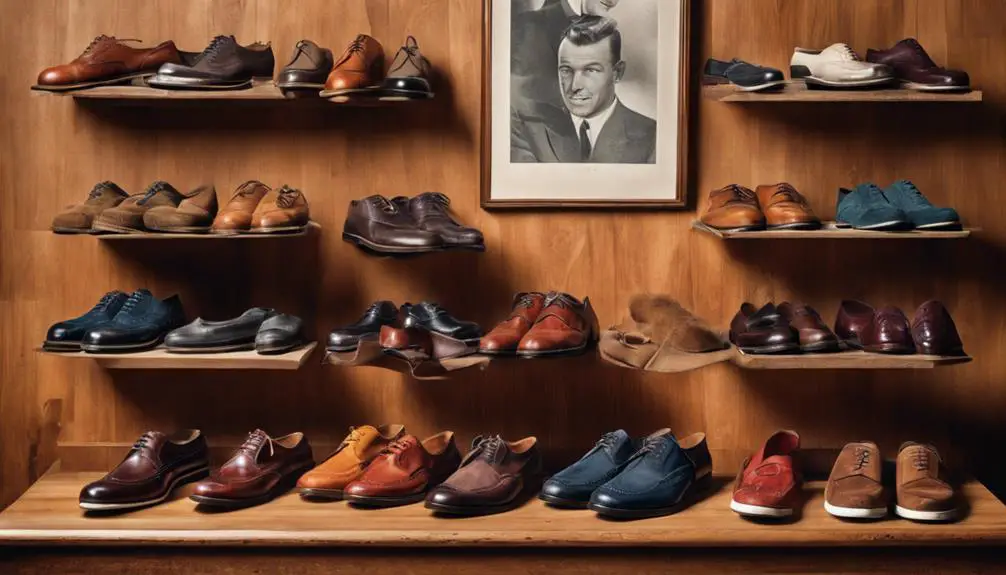
During the 1950s, footwear materials not only defined style but also reflected the practical needs of the era. The choice of materials was essential for both fashion and functionality, emphasizing quality craftsmanship that you could appreciate.
- Leather: The reigning champion of shoe materials, prized for its durability and polish, making it perfect for formal occasions.
- Suede: A softer, relaxed alternative, suede gained popularity for loafers and casual styles, adding a touch of laid-back sophistication to your wardrobe.
- Canvas: Lightweight and versatile, canvas dominated the sneaker scene, offering comfort for both athletic pursuits and casual outings.
- Waterproof options: Many boots featured waterproof materials to tackle various weather conditions, allowing you to maintain style without sacrificing practicality.
The combination of these materials showcased an era where attention to detail and handmade craftsmanship flourished. Each pair of shoes was not just an accessory but a statement of quality and elegance, reflecting the lifestyle you aspired to. Whether you were stepping into a formal event or enjoying a casual day out, the right materials made all the difference in your footwear choices.
Lasting Impact on Fashion
Footwear from the 1950s didn't just set the stage for style; it ignited a revolution in men's fashion that's still felt today. The era's iconic black leather shoes and white oxford shoes became symbols of youthful rebellion, paving the way for a more casual yet polished aesthetic. You can see their influence in contemporary fashion, as versatility reigns supreme in both casual and formal settings. The craftsmanship of these shoes, often highlighted by vintage clothing labels, reflects a dedication to quality that many modern designs endeavor to replicate. Additionally, understanding vintage clothing labels can enhance appreciation for these timeless pieces.
Rockabilly boots, with their striking pointed toes and shiny finishes, merged country and rock elements, becoming a staple in the wardrobes of music lovers and fashion enthusiasts alike. This blend of styles continues to inspire modern designs, proving that the spirit of the 50s remains alive.
As you navigate today's vintage markets, you'll notice how 1950s trends, like penny loafers and casual slip-ons, still resonate. They're not just relics of the past; they're a reflection of a time when footwear became a form of self-expression. So, next time you lace up those sleek black leather shoes or slip into some classic white oxfords, remember that you're not just following a trend; you're stepping into a legacy.
Frequently Asked Questions
What Men's Shoes Were Popular in the 1950s?
You'd notice saddle shoes with their eye-catching black and white design, penny loafers for versatility, and sleek rockabilly boots showcasing rebellion. Vintage sneakers and polished oxfords would complete your stylish, trendsetting footwear lineup.
What Were Men Expected to Wear in the 1950s?
In the 1950s, you were expected to embrace a polished look, donning tailored suits, crisp shirts, and sleek hairstyles. Casual wear included rolled-up jeans and fitted tees, reflecting the exciting blend of rebellion and refinement of the era.
What Shoes Did Men Wear in 1940s?
In the 1940s, you'd find men sporting classic lace-up oxfords, loafers, and saddle shoes. Military boots emerged too, showcasing durability, while casual slip-ons and canvas sneakers hinted at a shift towards relaxed fashion.
What Shoes Did Men Wear in 1960s?
In the 1960s, you'd sport sleek Chelsea boots and stylish loafers, embracing mod culture with sharp brogues or casual sneakers. Platform shoes emerged, adding flair, while reflecting your individuality and the decade's bold fashion trends.
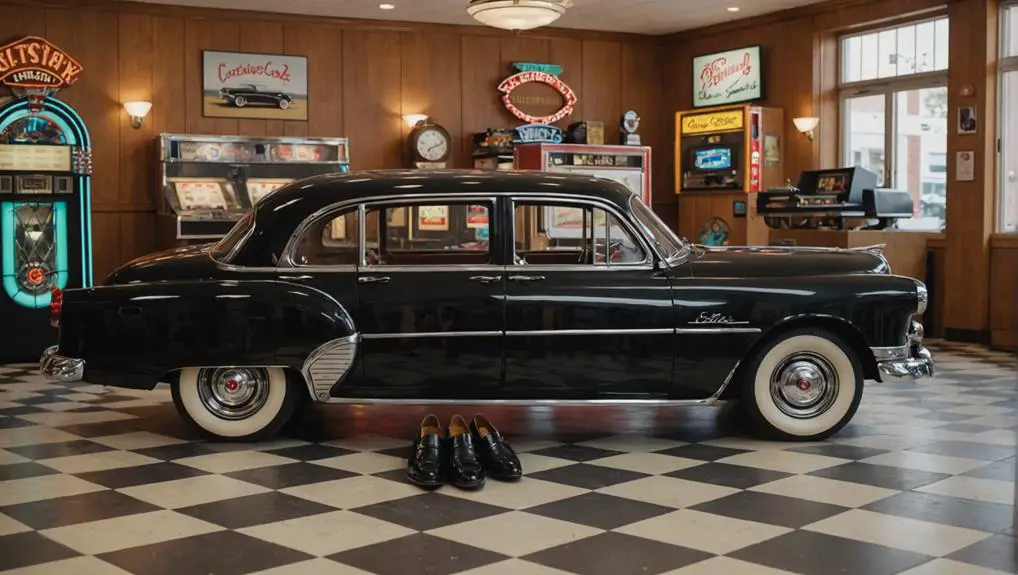

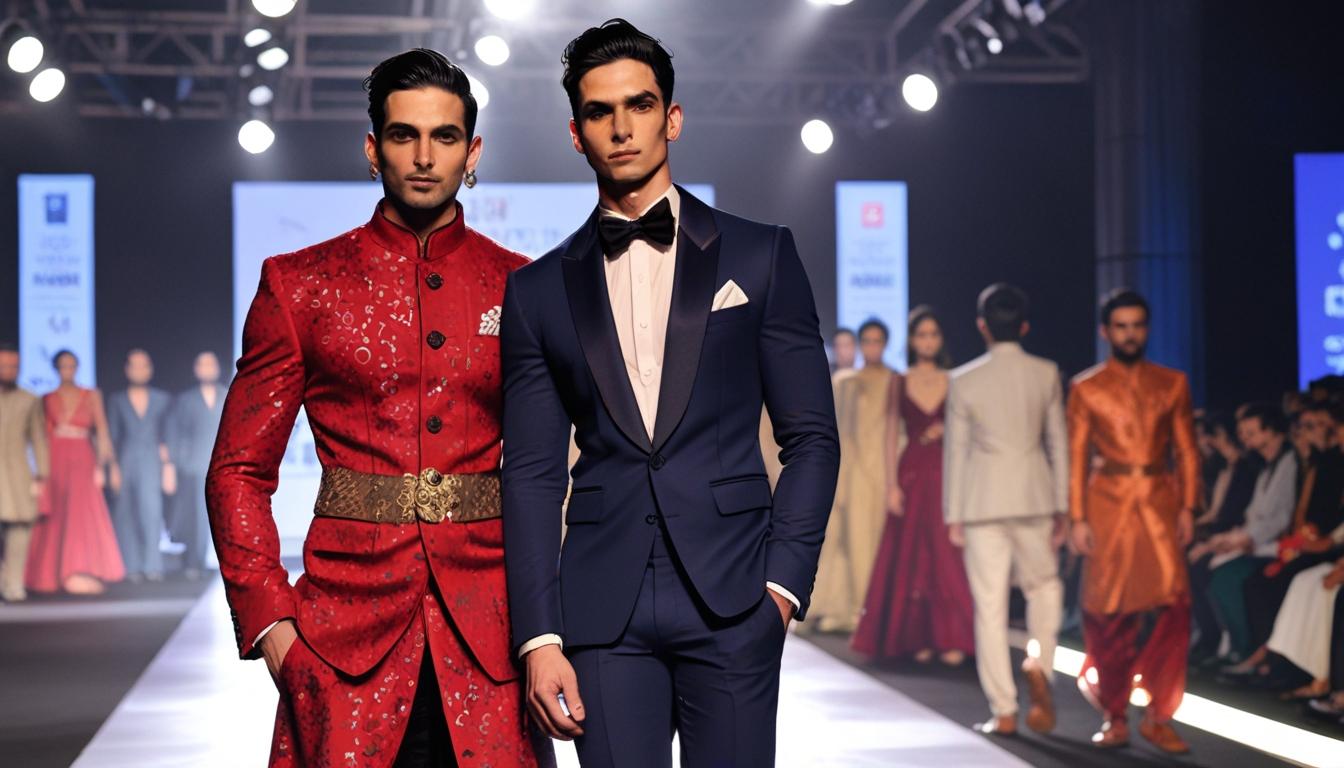
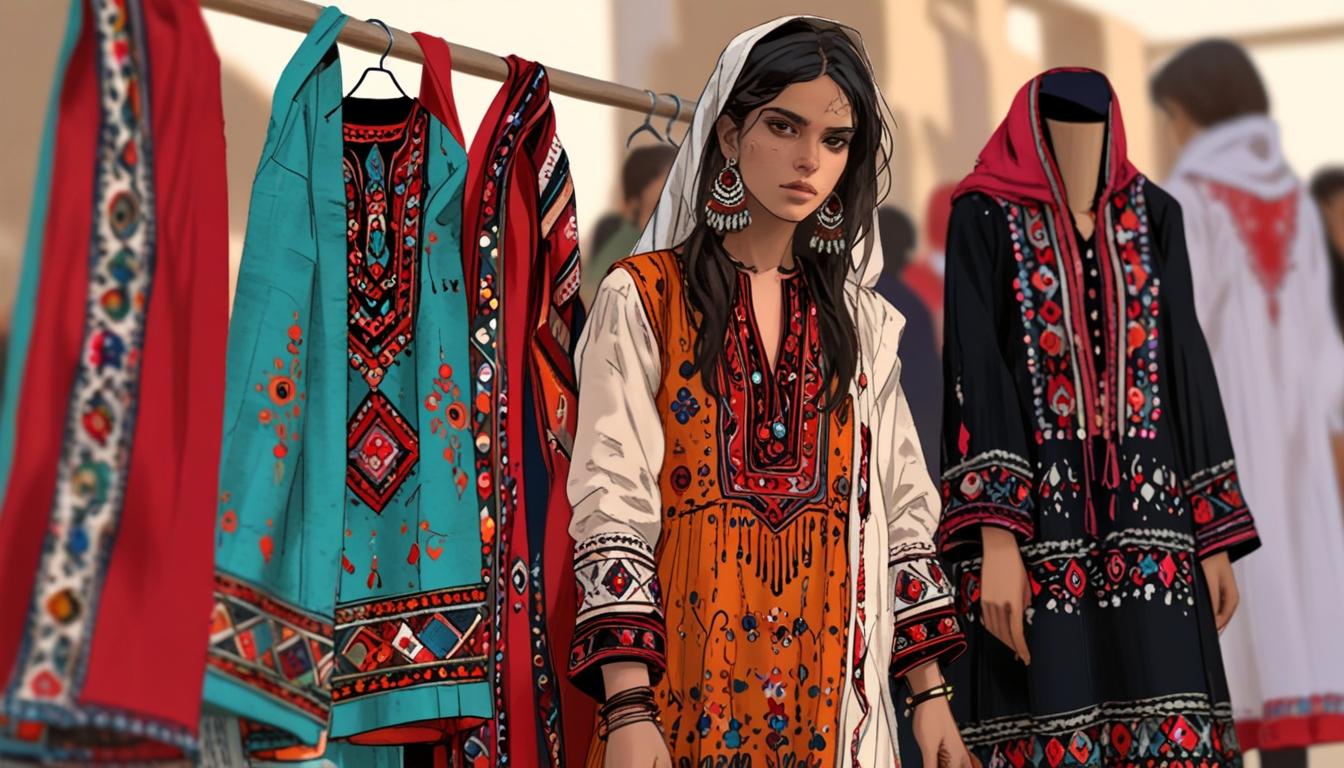

I want to thank you for your assistance and this post. It’s been great. http://www.kayswell.com